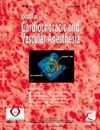心脏手术后重症监护病房转运过程中手动和机械通气的比较:对氧合、通气和血流动力学稳定性的影响。
IF 2.3
4区 医学
Q2 ANESTHESIOLOGY
Journal of cardiothoracic and vascular anesthesia
Pub Date : 2025-03-01
DOI:10.1053/j.jvca.2024.12.017
引用次数: 0
摘要
目的:心脏手术后,患者在转运至重症监护病房(ICU)期间经常需要通气支持。通常采用袋式阀面罩(BVM)进行人工通气;然而,出于对氧合、通气和血流动力学稳定性的考虑,机械通气有时可能是首选。手动和机械通气之间的决定通常基于临床经验和手术因素,因为没有既定的共识或强有力的临床证据来指导这种选择。本研究的目的是比较BVM手动通气和运输呼吸机机械通气之间的氧合、通气和血流动力学参数。设计:前瞻性单盲临床试验。环境:单中心三级学术医院。参与者:共有48名在2023年9月至2024年8月期间接受心脏手术并转移到ICU的患者被纳入研究。干预措施:符合纳入标准的患者被随机分配到两组中的一组:第1臂患者在转运至ICU期间使用BVM进行手动通气;第2组患者在转运至ICU期间使用运输呼吸机进行机械通气。测量结果及主要结果:两组PaO2/FiO2比值、PaCO2转运前后百分比变化无显著性差异(p分别为0.133、0.902)。然而,BVM组的低血压(定义为平均动脉压下降10%)明显高于机械通气组(p = 0.00986)。结论:在接受心脏手术的患者中,BVM组在转运至ICU期间低血压的发生率高于机械通气组。然而,两组之间的氧合和通气参数具有可比性。本文章由计算机程序翻译,如有差异,请以英文原文为准。

Comparison of Manual and Mechanical Ventilation During Intensive Care Unit Transport Following Cardiac Surgery: Impact on Oxygenation, Ventilation, and Hemodynamic Stability
Objectives
Following cardiac surgery, patients often require ventilatory support during transport to the intensive care unit (ICU). Manual ventilation using a bag valve mask (BVM) is commonly employed; however, mechanical ventilation may sometimes be preferred due to concerns regarding oxygenation, ventilation, and hemodynamic stability. The decision between manual and mechanical ventilation is typically based on clinical experience and surgical factors, as there is no established consensus or robust clinical evidence to guide this choice. The aim of this study was to compare oxygenation, ventilation, and hemodynamic parameters between manual ventilation with a BVM and mechanical ventilation using a transport ventilator.
Design
A prospective, single-blinded clinical trial.
Setting
A single-center tertiary academic hospital.
Participants
A total of 48 patients who underwent cardiac surgery and were transported to the ICU between September 2023 and August 2024 were enrolled.
Interventions
Patients meeting the inclusion criteria were randomly assigned to one of two groups: Patients in Arm 1received manual ventilation using a BVM during transport to the ICU; patients in Arm 2 received mechanical ventilation using a transport ventilator during transport to the ICU.
Measurements and Main Results
Percentage changes in the PaO2/FiO2 ratio and PaCO2 pre- and post-transport were not significantly different between the two groups (p = 0.133 and 0.902, respectively). However, hypotension, defined as a >10% decrease in mean arterial pressure, was significantly more frequent in the BVM group than in the mechanical ventilation group (p = 0.00986).
Conclusions
In patients who have undergone cardiac surgery, hypotension occurred more frequently in the BVM group than in the mechanical ventilation group during transport to the ICU. However, oxygenation and ventilation parameters were comparable between the two groups.
求助全文
通过发布文献求助,成功后即可免费获取论文全文。
去求助
来源期刊
CiteScore
4.80
自引率
17.90%
发文量
606
审稿时长
37 days
期刊介绍:
The Journal of Cardiothoracic and Vascular Anesthesia is primarily aimed at anesthesiologists who deal with patients undergoing cardiac, thoracic or vascular surgical procedures. JCVA features a multidisciplinary approach, with contributions from cardiac, vascular and thoracic surgeons, cardiologists, and other related specialists. Emphasis is placed on rapid publication of clinically relevant material.

 求助内容:
求助内容: 应助结果提醒方式:
应助结果提醒方式:


